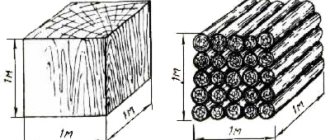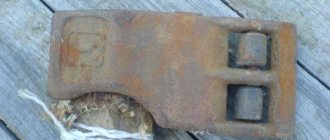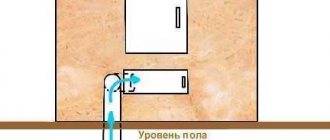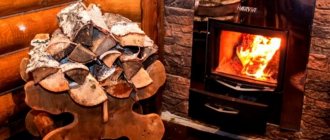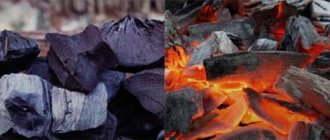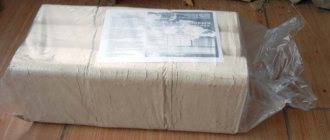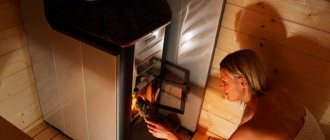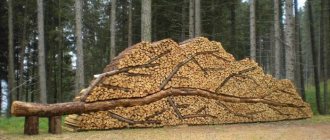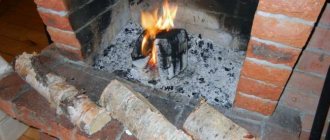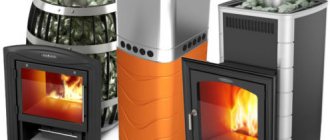What is the best way to heat a bathhouse?
Oak firewood
The oak must be middle aged. Young oak does not provide the necessary heat, and fills the bathhouse with the smell of charcoal. An old oak tree contains a lot of decayed wood, which produces more ash than heat. The air in a bathhouse heated with old oak will be heavy. Good firewood fills the bathhouse with heat and the aroma of forest and freshness.
Birch firewood
The most common firewood is birch. They light up easily and burn with a long, even flame. The heat from the stove heated with birch wood disinfects the bathhouse, filling it with a light fragrant aroma. However, birch firewood becomes less fragrant after two years of storage. In addition, if the air dosage in the stove is incorrect, when the wood burns smoky, tar and birch resin are sublimated along with the smoke. It settles quite abundantly on the walls of the pipe, and sometimes flows down if the pipe is thin-walled and cools easily. The abundance of tar on the pipe walls is a fire hazard.
Linden firewood
Since ancient times, linden firewood has been used in special cases. For warriors who were wounded in battles with enemies, hot baths were heated with linden wood, and they were given a decoction of linden blossom with linden honey. Linden spirit in the bath is healing for the skin and respiratory system. Linden is quite difficult to light, it flares up slowly, but its fire is long and persistent. Linden firewood should not be stored for more than two years.
Alder firewood
In Russia, alder firewood is considered royal firewood. Along the end and the chip, they turn reddish in air and are sharply different from other logs. Alder wood burns hot and produces almost no smoke. For firewood, it is better to choose alder on soils with the least moisture. A sauna heated with alder wood has an anti-cold effect. Alder firewood dries quickly enough and retains its unique smell for a long time. Even after three years, alder firewood retains its specific aroma.
Aspen firewood
In the villages they say: aspen does not burn without kerosene. This is because aspen wood is quite difficult to light. If aspen is placed in an already heated stove, it burns quite hot and holds the heat for a long time. In villages they also believe that aspen wood, when burned, cleans the chimney. Aspen firewood is usually cheaper than others. As a rule, aspen is a clumsy tree and is not fully used; there is a lot of waste, which is used for firewood.
Coniferous firewood
The most common firewood is softwood, spruce and pine. Pine, due to its higher resin content, burns hotter than spruce. It should be remembered that in resinous wood, when burning, a sharp increase in temperature, the resin sinuses burst, small cavities in the wood where resin accumulates. and this causes a characteristic crackling sound and sparks fly in all directions. Including through the open oven door. When you add firewood or mix it with a poker, it is better to wear glasses to protect your eyes. And when the stove door is closed, look carefully at the floor near the stove to see if a spark has flown somewhere. It is better to prevent a fire than to put it out.
Coal
Often, instead of firewood, coal is used for kindling, which has both advantages and some disadvantages. First of all, the use of coal is more profitable, since it requires less wood to heat a bathhouse than firewood, and in addition, the heat from burnt coal remains for quite a long time. The disadvantages include the increased humidity that appears during combustion, as well as the lack of aroma that burning wood gives.
In no case should you use old things, garbage, etc. for the firebox, as many materials are toxic and can harm those steaming.
It is known that 1 kilogram of dry firewood provides 2800 kcal. To get these calories when burning different types of wood, you need to take the appropriate amount (in kilograms) of firewood, depending on its volumetric weight. Volumetric weight of firewood in kg/cubic meter. to get 2800 kcal:
What type of wood is best for firewood?
Different types of wood differ from each other in their calorific value and combustion characteristics. In this regard, when choosing fuel, you need to understand the performance characteristics of firewood.
- Pine has a high combustion temperature. The reason for this is the high resin content. This rock suggests many voids where tar deposits are present. When burning, they produce micro-explosions, sparks and ignited pieces of wood fly away.
- Spruce is less efficient in a firebox than pine. It contains less resins. Splitting wood is easy, but when burning the tree smolders and smokes. These conifers can be used for heating only in extreme cases.
- Alder. The main feature is the ability to burn without forming soot. At the same time, during combustion, deposits in the chimney will also be burned out. Such characteristics are unique to aspen.
- Poplar. It burns out quickly without providing enough heat. It should not be used to heat a bathhouse, but it is quite suitable for a home.
- Birch. Burns hotter than beech with acacia and oak. But there is also a drawback, and a significant one. It is necessary that there is sufficient air flow into the combustion chamber. Otherwise, there will be no heat, but only tar and smoke on the walls of the chimney.
- Oak. It is distinguished by its high density and ability to release heat. Its characteristics are similar to ash and also resemble beech. Oak wood is quite heavy when splitting.
- Maple. Its wood burns quickly without forming coals, as a result, there is a need to constantly add fuel. It's like burning linden wood.
- Apple trees. Like other fruit species, it pricks well and produces enough heat when burning. Apple firewood is also preferred because of the pleasant smell in the room.
Here's what else the stove maker said.
Russian men are more willing to share bonuses with their significant other than women
The Ministry of Labor will simplify the receipt of benefits for Russians from 2022
Every third Russian during the pandemic had a job with a high salary
Answers from experts
It's Ost Ukraine:
Better. Poplar smolders more, pine gives off little heat. Maple is somewhere next to aspen, after acacia and oak. Since this question came up, I’ll add it too))) The most heat-giving ones are acacia. Even raw ones flare up in no time))
Walking by Myself:
poplar is very energy-intensive, I can’t tell you about the others
Olga Meshkova:
Pine logs burn hotter and longer than maple ones due to the resin in them. Birch firewood is also good - it burns hot. Maple is like a flame. Poplar is just soft wood and that’s it. It's easier to prick. If you choose firewood, then pine and birch. Pine splits more difficult than birch.
Irina Ivina:
In our area, the most valuable firewood is pine and birch (hot) and add a little aspen (cleans the chimney of soot). The Christmas tree is valued lower and is less prickly. Poplar and maple are not considered firewood
Roman Shved:
In short, buddy!!! My advice to you: delete the previous answers. The worst firewood: spruce, pine, poplar. They burn quickly, but are of no use. One headache. Common firewood: birch, alder, aspen. Firewood for “millionaires” is maple, ash, oak, hornbeam, beech, and rowan. For “millionaire” gourmets, all the firewood is from fruit trees. And if you have maple ridges more than 1 meter long... I envy you. Feel free to sell them to a furniture factory or private carpenters... they will kiss your ass and bring you 10 cubic meters of production waste for free to fire the stove.
Maxim Paromoshin:
As far as I know: alder was considered “royal firewood”, with a lot of heat and little soot. Poplar - don't take it. There is not enough heat (in my experience). Empty tree. Birch is the most popular and good firewood. Aspen - if available - is good for cleaning a chimney.
Lone Wolf (EW1AAD):
Easily! The calorie content is not very high - but you can burn it - the chimney will not become clogged with soot)
Andrey Kostenko:
Anything is good for firewood, but if you have to choose, birch is the best heating product, and poplar is empty shit.
Goon Goon:
But I live in the city and I don’t know.
AUH:
It's good, but it stinks when sawing
Metin Çiftci:
vice versa! The chimney will have to be cleaned more often! poplar burns quickly, warms, but the heat quickly evaporates!
Maksvel-haus:
Everything is burning in the stove, but the warmth comes from the birch and fir trees.
Kotofey:
It's a pain to inject, it burns out quickly and the heat transfer is low
Valya Tyutchenko:
I live in Kuzbass in a small town, this is the second year we have been exterminating poplars and selling them to the population for firewood. They are quite suitable for lighting coal. But I don’t think so much as an independent fuel. You didn’t write that you want to heat a bathhouse, a fireplace, or a stove in the house for heating.?
Daria Vikhrova:
We are engaged in cutting down city poplars, people often ask, we give them away for free
Semyon Altakh:
I picked up a felled poplar, chopped it, flooded it, and how it fucked me up. It doesn’t burn if you don’t burn anything except the poplar; it doesn’t burn at all, but it’s a little damp for me. What I like about poplar when it burns is its wonderful smell, I absolutely love it and the fact that it’s free
Oksana Bobinskaya:
It burns well together with birch. Creates a wonderful smell inside the bathhouse. There is almost no waste.
How to heat correctly?
To reduce wood consumption and improve combustion, the stove maker advised doing the following:
- You need to put logs into the stove that are approximately 5 cm shorter in size than the length of the firebox. If, when preparing firewood, you make it approximately the same size, it will be much easier to burn.
- The logs are laid in such a way that there are gaps for air.
- Although the stove can, in principle, be heated with raw wood, this is fraught with the release of tar with smoke and in considerable quantities. In this regard, it is better to deal with dry fuel (no more than 25 percent humidity).
And finally - about how to start lighting the stove.
The heads of Russian companies have become more optimistic about economic prospects
The lifting of coronavirus restrictions provoked an increase in conflicts in Russian business
Deception from publishers and rising fees. Story by Andrzej Sapkowski
Instructions on how to properly heat a sauna
- The hardest part is kindling. First of all, open the valve in the pipe, otherwise carbon monoxide will not escape. Be sure to check that this condition is met before each kindling.
- Chop some wood and prepare 4 logs. In addition, you will need newsprint.
- Place 6-7 crumpled sheets of paper in the oven. Place wood chips on them, and mark 4 logs on top, preferably perfectly dry ones. Moreover, it is advisable to distribute the logs across the entire width of the stove, rather than stack them on top of each other.
- Light the paper under each of the logs and quickly close the firebox, otherwise you will release smoke. Don't be afraid, 95% of the time the fire will flare up, so you don't have to watch it with the firebox open.
- After 15 minutes, add more firewood. How often to add them in the future depends on their dryness, but in the first hour of the fire, the main thing is not to miss the moment - to add them when the old firewood, which has turned into coals, begins to break into several parts. After about 1.5-2 hours, the temperature in the firebox will rise significantly, and it will be possible to add fuel even when there are only coals left in the stove.
- Place new firewood as close to the door and as far from the chimney as possible. This way you will increase the area of contact between the fire and the pipe, thereby reducing the time it takes to heat the bathhouse.
- If there is good draft (this is evidenced by bright red, as if swollen, coals in the firebox), after 2 hours you can close the valve halfway. This will also reduce the time you spend heating the sauna and save fuel.
- It is better to steam brooms directly in the steam room, when it has reached at least 60°C.
- Do not start heating the sauna if there are wooden containers in the steam room (for example, a bucket from which you throw it) that are not filled with water. This will lead to their rapid drying out.
- If the sauna is new, heats well, and you are happy with the temperature, then you can start steaming. The valve can only be closed when all the carbon monoxide has left the firebox. If, after stirring the coals in the firebox, you see a bluish-greenish flame appear, then carbon monoxide is still present. In a bathhouse that is difficult to light and quickly loses temperature, it is necessary to remove all the coals from the firebox and completely close the valve.
In order for the bathhouse to always smell good and have good heat, you need to take care of the quality of the firewood. Bad firewood can cause unpleasant odors, such as mold or swamp, to appear in the sauna, and, in addition, much more firewood than usual may be needed to heat the steam room.
How to heat a sauna with an iron stove?
The main rule when firing an iron stove is to add frequent and small volumes of logs. Otherwise, you can provoke overheating and long cooling. For comparison, you can safely put a large load of logs into the same brick stove and leave it to “reach” the required temperature.
Differences between an iron stove and a brick version:
- the metal counterpart warms up faster. For example, after twenty minutes from the moment of kindling, it reaches the optimal operating mode. The room warms up faster and better;
- the consumption of firewood in an iron stove is an order of magnitude greater than in its brick counterpart;
- a metal stove does not always maintain the same temperature in the chimney and firebox.
How to balance all the “poles” and “cons” of an iron stove? There is an option to use a shield made of bricks in a metal stove, or to build a brick chimney with a so-called “liner” made of stainless steel for a metal stove. There is also the option of covering a metal stove with bricks to increase the heat transfer time.
Instructions for lighting an iron stove:
- A small amount of paper is placed at the bottom of the firebox.
- Logs are laid out on the paper, but so that there is a small gap between them. When the firebox is about two-thirds full, leave some free space on top and set fire to the logs.
- When updating a batch of firewood, you still need to wait until the previous one burns out thoroughly.
Common mistakes when lighting an iron stove:
- Too much wood in the stove;
- The logs lie tightly in relation to each other - this is the first cause of smoke. Gases must circulate freely in the stove;
- The stove vent closes too early, which also leads to disruption of the gas circulation process.
- Powerful draft and too much fire do not mean that the stove is burning correctly. With the right approach, you can achieve good heat by slowly burning a small amount of logs.
To compare the quality of steam in a bathhouse with brick and metal stoves, as well as a black bathhouse, select the appropriate option in the catalog of steam rooms in St. Petersburg, where all bathhouse establishments in the city are presented.
The best firewood for a sauna based on wood density
First of all, it is worth noting that they are:
- Solid (with high calorific value and long-lasting heat in the combustion chamber - oak, ash, hornbeam, maple);
- Medium-hard (with less heat release - cherry, apple, pear, alder, birch, larch, pine);
- Soft (with a minimum percentage of room heating due to rapid combustion - aspen, alder, willow).
Of course, firewood from the first group is preferable for a bathhouse, since it is dense, finely porous, producing coals that do not go out for a long time and a sufficient level of heat.
The next type is loose trees with low density. They maintain a bright flame, but go out very quickly, with virtually no time to give off heat.
Important component 3 - the correct combustion algorithm
We place two logs parallel to each other on the grate at a distance of 10-15 cm. Between them is a crumpled sheet of paper, which we cover with wood chips or shavings. The “seed” is completed by two more logs laid diagonally on top.
We set fire to the “seed”
Using a match or kitchen lighter, light the wad of paper in the “seed”. You cannot use flammable liquids to speed up ignition: gasoline, diesel fuel, kerosene, xylene, acetone, etc. If the firewood is damp and cannot be ignited, you can use a dry alcohol tablet. We wait for the characteristic flame noise to appear in the stove, close the firebox door and cover the vent (not completely).
Throwing wood into the stove
The “seed”, of course, will not be enough to light the stove. Therefore, to continue combustion, you will have to add firewood from time to time. The first time this is done 10-15 minutes after igniting the “seed”. We open the firebox door, level with a poker everything that remains of the “seed” and place the firewood in approximately 2/3 of the volume of the stove firebox.
In the future, a new portion of firewood is laid when the old one burns out - approximately once every 1-1.5 hours.
We complete the heating of the bathhouse
In winter, the sauna is heated for at least 5-6 hours, in summer it is faster - on average 3-4 hours. When the bath has heated to the required temperature, the firebox can be finished. We wait for the last portion of firewood to burn out, open the firebox door and check for bluish flames above the coals - signs of the presence of carbon monoxide. If everything is in order, close the vent, smoke valve and firebox completely.
After everything has been done, we open the doors of the steam room and the window so that the bathhouse can be ventilated. 15 minutes is enough for the bathhouse to be filled with fresh air. After that, close everything except the window. The bath should last for about two hours. Don’t be afraid, during this time it will not have time to cool, but the heat will become soft, uniform, and the steam will become light. Afterwards we close the window and begin the bath procedures.
There are three answers to this question: from a practical, health-improving and economically beneficial point of view.
- The first insists that hard types of wood should be used for a bathhouse, since they burn longer and produce more heat.
- The second states: it is preferable to take “healing” logs that have the most positive effect on the body.
- The third speaks about the advisability of using only firewood for heating that is obtained directly on site and, therefore, is inexpensive.
Important component 2 - oven preparation
Now that the firewood has been selected, you can think about lighting the sauna stove. First you need to prepare it - we will melt it later. We follow the instructions:
- We clean the grate and ash chamber (ash pan) from ash and coals;
- Wash stones in clean water;
- We determine whether there is draft (chimney permeability) necessary for carbon monoxide to escape from the stove.
To do this, open the smoke valve in the chimney, the firebox and ash doors. Then we bring a lit match into the firebox and watch where the flame rushes. If it goes up, that is, it is drawn into the chimney, then everything is in order - there is draft. You can start kindling. Otherwise, you will have to first clean the chimney, since it is prohibited to heat the bathhouse without draft - the stove will “smoke”.
Step-by-step instructions for properly heating a sauna
As we already wrote above, firewood for a bath must be dry and of high quality, and this directly depends on its proper storage.
If you prepare your own logs for kindling, then they need a dry and protected place, such as.
Wash the stones, make sure there is enough clean cold water for washing. Open the valve on the pipe through which harmful carbon monoxide will escape. Prepare wood chips for kindling and 4 logs. Place them on the stove grate, spreading them across its entire width. Then stick a few crumpled up sheets of paper or newspaper into the oven. Light them and close the firebox door. After 15 minutes, you can throw in a couple more logs. How often you will have to add firewood during the first 1.5–2 hours of kindling depends on how dry it is and how quickly it burns out. The main thing here is not to miss the moment when the burnt tree, which has become coals, begins to split - then you need to throw the next portion of logs. When the temperature in the firebox becomes high enough, firewood can be added less frequently, even after there are only coals in the stove. In order for the fire to burn better and the time to kindle the bathhouse to be shorter, new firewood should be placed closer to the stove door and away from its chimney. If the draft is strong enough, and this can be seen by the presence of red swollen coals in the firebox, after 2 hours the valve can be closed halfway
This will not only save fuel, but will also speed up the process of warming up the bath. It is important to periodically stir the coals with a poker, but try not to touch the hot firebox door to avoid getting burned. Laying a new portion of firewood must be repeated several times. In summer, the sauna is heated for about three hours in a row, and in winter for at least 5 hours
In this case, it is necessary to control the water level in the boiler, add it in time, not allowing it to completely evaporate. After you feel that the bathhouse has warmed up well, you need to thoroughly ventilate it again, opening all the windows and doors. If you have
The firebox is a whole ritual. Let's take a closer look at all the subtleties of bath art.
Before stacking firewood in the firebox, the grate and ash chamber are cleaned of residual combustion products in order to completely free access of air to the burning fuel, otherwise a stove with a ash pit will turn into a stove with a blind hearth, which is uneconomical. Increased humidity in wood impairs combustion, so they must be dried beforehand.
It is necessary to stack firewood with gaps and in such a way that there is at least 200 mm left to the top of the firebox. It is advisable to heat the bathhouse with dry birch wood, which produces less soot, or aspen, pine, oak, spruce, etc.
You cannot throw painted wood, plastic, roofing felt, or bitumen into the firebox. Do not overheat the stove: cracks will appear in the lining and masonry. When there is no bluish-blue flame above the remaining coals in the firebox (a consequence of the combustion of poisonous carbon monoxide, the so-called carbon monoxide), the firebox is considered complete. After 5-10 minutes, you can tightly close all doors and dampers.
To avoid carbon monoxide poisoning, do not light the stove late in the evening. If the design provides for the stove to operate on coal or anthracite, the valve should be installed in such a way that it does not close tightly and leaves a gap of at least 10-15 mm.
First, light the stove with small wood. A 50-60 mm layer of coal is poured onto them. After the coal burns well, the backfill thickness is adjusted to 150 mm, but no more, otherwise fuel consumption will be uneconomical. After the fire is completed, the remaining coals are raked onto the grate so that they are well blown with air coming from the ash pit.
If there is no grate, rake it closer to the outlet of the oven. If there is excessive gas formation in the firebox, a flame may erupt. This usually happens when they try to light the stove with flammable liquids (gasoline, kerosene, etc.). If the concentration of gases is high, an explosion may occur, which can not only destroy the furnace, but also cause a fire.
The firebox cannot be loaded with a new portion of fuel (especially fine-grained fuel), completely covering the hot surface of the furnace bottom: it “languishes,” releasing a large amount of volatile substances, without flaring up due to the lack of flame and a decrease in temperature. In this case, the concentration of gases increases sharply and at the first appearance of a flame an explosion occurs.
Therefore, fine fuel must be loaded into the furnace in small portions, giving it the opportunity to flare up gradually
The fire door must be opened carefully so as not to cause a sudden fire.
The best firewood for a bath in terms of savings
Hornbeam, maple, ash, and oak are incredibly expensive, so the population makes a practical choice in favor of those trees that grow en masse in their region. Birch and aspen are especially often chosen - they are healing, provide enough heat, and do not clog the chimney too much with soot.
But the most important requirement is dryness. The wood must rest so that the percentage of water in it does not exceed 15-20 units. It is this type of firewood that burns hot, melts easily and emits a fragrant odor. The right time to harvest logs for a bathhouse is winter, in particular January and February, when the wood is frozen and there is a minimum of moisture in it.
The main indicator for firewood is its degree of thermal conductivity. When choosing firewood for a bathhouse, this factor must be taken into account. More experienced bathhouse attendants endow them with special mystical powers, carefully sharing recipes for kindling and maintaining the fire.
Time moves inexorably and modern technologies and scientific knowledge come to the aid of lovers of good steam. Thanks to this, it is possible to achieve the desired result at lower costs.
Burning wood from different types of wood
When our person chooses firewood, he is guided by three criteria: cheap (if you buy), fast/easy (if you chop the wood yourself) and carry it nearby. And everything else is no longer so important, firewood is firewood in Africa too. But there is one nuance... More precisely, more than one, but this becomes clear in the process of building a fire or servicing a stove, fireplace or hearth. The fact is that firewood from different types of wood burns very differently. And we will tell you about it now.
The content of the article
Features of burning firewood from different types of wood
Birch firewood
Birch wood burns evenly, releasing a large amount of heat and for a long time. Making a fire from birch is a nice thing. You can forget for a long time that it needs to be updated somehow. And common sense itself ordered the use of birch bark as kindling. Thin, dry, lights up well.
But there is one nuance that makes birch undesirable as kindling for a fireplace. Soot. A huge amount of greasy soot, which easily falls off and completely clogs the chimney. Well, what did you want? It’s not just that they drive tar out of birch trees.
Aspen firewood
Aspen does not burn very well because the wood “flakes.” So much so that cavities form in the center of old trunks. And liquid actively accumulates in it, which can lead to accelerated rotting of the wood.
Therefore, the burning of aspen wood is accompanied by a crackling sound. But it burns with virtually no soot formation. Moreover, if you alternate aspen with something that smokes, you don’t have to worry too much about the condition of the chimney. So this is a good solution for fireplaces, but in the forest, an aspen fire will not be very effective.
Willow firewood
Willow burns very quickly and is quite hot. But not for long, leaving behind a small amount of coal. For a fireplace, this is not the best option, since you will have to constantly add firewood. For the fire, too. It makes sense to burn willow firewood only in situations where a fire is needed that is hot but short-lived. Dry clothes, boil tea.
Alder firewood
Alder firewood burns slowly, but is very hot. There are a lot of coals left, but there is practically no soot and soot. So for a fireplace - just right. But it’s better to first achieve high temperatures with something, so that the further process goes easier.
Oak firewood
Oak firewood burns beautifully and produces a lot of heat. The wood is dense, does not crack, and produces almost no soot. And it holds the heat superbly. Ideal for both fireplaces and campfires. But finding oak firewood is very difficult these days. Or expensive. But it's worth it.
Pine firewood
Pine burns hot, brightly and with a bang - yet it is difficult to find a tree containing more resins. And these resins then safely settle on the walls of the chimney. So if you use pine, then only at the initial stage, so that the desired heat is achieved. And then it’s worth throwing in something more stable. Dry pine needles are no worse kindling than birch bark.
Ash firewood
Ash burns well; burning wood is accompanied by the release of a large amount of heat and light. Approximately at the level of oak, so suitable for heating large rooms. But they also cost more than other types. Another problem is that ash is difficult to harvest. In this case, knowledgeable people recommend that you first freeze the tree properly, and then the process will proceed on its own.
Poplar firewood
Poplar firewood burns quickly, but not for long. They provide little heat, so you have to constantly renew the fireplace or fireplace. Harvesting poplar is also not very convenient - it is cut and sawed rather poorly. But with all this, it is one of the cheapest options. You just have to pay more due to the quantity required. So it is better to use poplar only in extreme cases.
Firewood from fruit trees
Fruit trees can be combined into one group, since firewood from them burns in approximately the same way - hard, but long. With the formation of a large amount of coals and a pleasant aroma in the process.
That is why it is better not to use them as the main kindling, but to add them to other types of firewood. For the same barbecue, for example, this is the best option, since the coals provide heat and aroma.
Cedar firewood
Cedar lights up well, burns very hot, but quickly. But it burns completely, leaving almost no coals. Ideal for a fire in the wild. For a fireplace, there is a high risk that resinous substances will clog the chimney.
Larch firewood
Larch is one of the most common trees on our territory. Larch firewood burns perfectly. Calm, long, leisurely, but with the release of a decent amount of heat. You can also ignore the soot, since there is practically none.
Some believe that larch is the “ideal firewood”. Since there are no problems with procurement, combustion, or subsequent disposal.
Important component 1 - good firewood
The choice of firewood determines how quickly your sauna will be heated and how hot the sauna will be. Preference should be given to hardwood: hornbeam, oak, ash, maple. These rocks have the highest heat transfer, that is, they release the greatest amount of heat during combustion. The calorific value of wood from fruit trees (apple, pear, cherry) is somewhat lower, but it also provides good heat in the oven. The calorific value of deciduous trees is even lower: birch, alder, etc. Despite this, deciduous trees are used most often due to their availability and low cost. Coniferous firewood is the least popular choice for heating a sauna stove. This wood produces little heat; in addition, when burned, it produces a lot of soot, which settles in the chimney and on stones.
Another important characteristic of firewood that is also worth paying attention to is humidity. The smaller it is, the better the sauna will be heated. Ideally, the moisture content of the wood does not exceed 20%
Freshly cut wood has a moisture content of 33 to 50%, so it burns poorly. To dry such firewood, it is enough to let it rest for some time in a dry, well-ventilated room.
Ideally, the moisture content of the firewood does not exceed 20%. Freshly cut wood has a moisture content of 33 to 50%, so it burns poorly. To dry such firewood, it is enough to let it sit for some time in a dry, well-ventilated room.
Now let’s figure out what kind of wood it is better not to heat the bathhouse with. Not suitable for this:
- old boards and logs - due to the unpleasant smell when burning.
- Rotten firewood burns poorly and produces a lot of ash.
- Wood impregnated with chemical compounds releases substances hazardous to health during combustion.
What kind of wood is best to heat a bathhouse?
Surely, you ask, what is the best way to heat a bathhouse? In Russia, birch wood is most often used to light the stove. They flare up very quickly and give an even and stable heat.
Firewood from other trees or coal can also be used to light a bathhouse, but their usefulness and calorie content when burned is much lower than that of the Russian beauty birch. For example, firewood made from oak or ash is quite expensive. Poplar and aspen have low heat transfer. Spruce and pine, although they smell very pleasant, can smoke heavily when kindled. When burned, coal emits toxic smoke. And only alder can compete with birch in terms of the quality of kindling in a sauna stove, but the aroma from its firewood will still not be so wonderful and pleasant.
What kind of firewood is preferable?
It is best to take firewood from hard, deciduous trees. When they burn, no resin is released, and the high combustion temperature is maintained without problems. An additional advantage is that soot remains to a minimum inside the chimney.
It is not advisable to heat the stove with garbage; it is also bad to use spruce and pine wood. On the contrary, it is good to heat with sawdust. Briquettes are also used; they are made from peat or wood. The fuel should have a moisture content of about 20 percent. It is present if the firewood is stored in a dry room for a year.
Data leakage: business named the most important threat to itself
Phillips sells $25 million worth of classic watches at Asian watch auction
Sobyanin recommended transferring a third of working Muscovites to remote work
